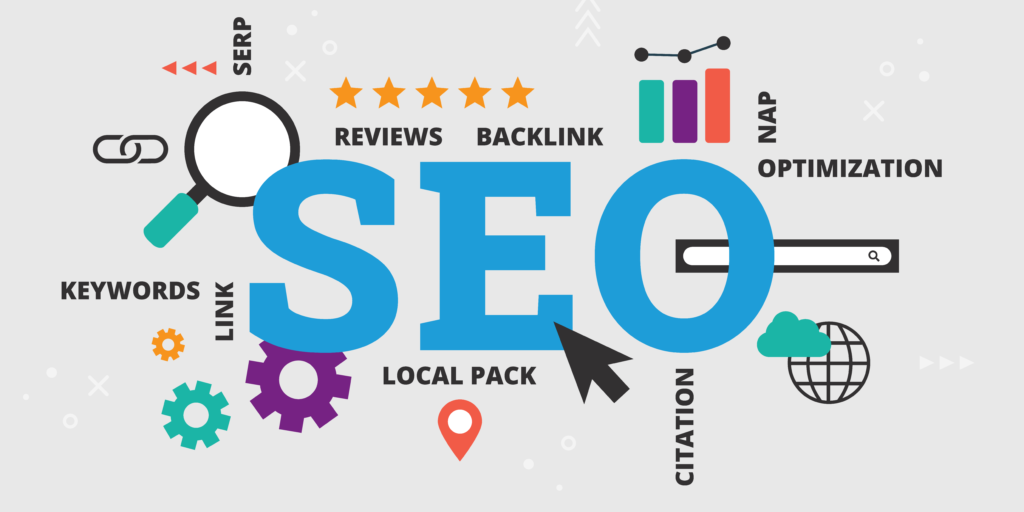In today’s digital age, having an online presence is essential for businesses and individuals alike.
Whether you’re a small local shop or a global corporation, the internet offers a level playing field for reaching your target audience.
However, the vastness of the online world means that standing out and being discovered can be a challenge.
This is where Search Engine Optimization (SEO) comes into play.
It is the art and science of making your website more visible and accessible to search engines, ultimately improving your chances of ranking high in search results.
In this comprehensive guide, we’ll explore the fundamentals of SEO, its importance, best practices, and the latest trends that will help you unlock the full potential of your online presence.

Table of Contents:
- What Is SEO?
- The Importance of SEO
- How Search Engines Work
- On-Page SEO a. Keyword Research b. On-Page Optimization
- Off-Page SEO a. Link Building b. Social Signals
- Technical SEO a. Website Speed b. Mobile Optimization c. Website Structure d. Security
- Local SEO
- Content Marketing and SEO
- SEO Analytics and Tools
- SEO Trends in 2023
- Conclusion
1. What Is SEO?
Search Engine Optimization, or SEO, is a digital marketing strategy focused on improving a website’s visibility and ranking in search engine results pages (SERPs). It involves a set of techniques and best practices that aim to enhance the quality and relevance of a website’s content, making it more attractive to search engines like Google, Bing, and Yahoo.
It can be divided into three main categories:
- On-Page SEO: This focuses on optimizing individual web pages to improve their rankings. It includes elements such as keyword research, content creation, and meta tags.
- Off-Page SEO: This involves activities carried out outside your website to improve its authority and trustworthiness. Link building and social signals are key components of off-page SEO.
- Technical SEO: This aspect deals with the technical foundation of your website, ensuring that search engines can crawl and index it efficiently. It encompasses website speed, mobile optimization, website structure, and security.
2. The Importance of SEO
SEO plays a pivotal role in the digital landscape, and its significance continues to grow. Here are some of the reasons why this is crucial for businesses and individuals:
a. Increased Visibility:
The primary goal of make your website more visible to search engines. When your website ranks higher in search results, more people are likely to discover and visit it. Increased visibility can lead to higher organic (non-paid) traffic, which is essential for long-term success.
b. Targeted Traffic:
That helps you attract the right audience to your website. By optimizing your content for specific keywords and phrases relevant to your niche, you can connect with users who are genuinely interested in what you offer. This targeted traffic is more likely to convert into customers or followers.
c. Credibility and Trust:
Websites that appear at the top of search results are often perceived as more credible and trustworthy. Users tend to trust search engines, and if your site ranks well, it can boost your credibility in their eyes.
d. Cost-Effective Marketing:
Compared to traditional advertising, A cost-effective strategy. While it requires an initial investment in time and resources, the long-term benefits are substantial. Once your site is well-optimized, you can attract organic traffic without continually paying for ads.
e. Competitive Advantage:
Your competitors are likely investing in SEO, so not doing so puts you at a disadvantage. To stay competitive in your industry, you need to keep up with best practices and trends.
f. Better User Experience:
Optimizing your website for SEO often leads to an improved user experience. Fast-loading pages, clear navigation, and relevant content benefit both users and search engines.

3. How Search Engines Work
To understand and succeed in SEO, it’s essential to grasp how search engines work. While the algorithms are complex and constantly evolving, the basic process can be simplified into the following steps:
a. Crawling:
Search engines use automated programs called “spiders” or “bots” to crawl the web and discover new web pages. These bots follow links from one page to another, indexing the content they find.
b. Indexing:
Once a page is crawled, its contents are indexed, meaning they are added to the search engine’s database. Indexing allows search engines to quickly retrieve relevant information when a user makes a query.
c. Ranking:
When a user enters a search query, the search engine looks into its index to find the most relevant results. The search engine’s algorithm then ranks these results based on various factors, including relevance, authority, and user experience. The results are presented in the order the algorithm deems most relevant, with the top-ranking pages appearing first.
It goal is to influence these ranking factors positively, so your website appears at the top of the search results when relevant queries are made.
4. On-Page SEO
On-page SEO involves optimizing individual web pages to make them more appealing to search engines. Here are the key aspects of on-page SEO:
a. Keyword Research:
Keyword research is the foundation of on-page SEO. It involves identifying the keywords and phrases that users are likely to search for when looking for information or products related to your website. You can use various tools like Google Keyword Planner, SEMrush, and Ahrefs to discover relevant keywords.
b. On-Page Optimization:
Once you have your target keywords, you need to incorporate them strategically into your content. This includes optimizing the following elements:
- Title Tags: The title tag is one of the most critical on-page SEO elements. It should include the primary keyword and accurately represent the page’s content.
- Meta Descriptions: The meta description provides a brief summary of the page’s content and should also contain the target keyword.
- Header Tags: Use header tags (H1, H2, H3, etc.) to structure your content. Include the target keyword in at least one header.
- Content: Create high-quality, informative, and engaging content that incorporates the target keyword naturally. Avoid keyword stuffing, which can harm your rankings.
- URL Structure: Use clean and descriptive URLs that include the keyword when relevant.
- Images: Optimize images by using descriptive file names and adding alt text with keywords when appropriate.
- Internal Linking: Link to other relevant pages on your website using anchor text that includes keywords.
- User Experience: Ensure that your website is easy to navigate and mobile-friendly.
5. Off-Page SEO
Off-page SEO is about building authority and trust for your website through activities that take place outside of your site. The primary components of off-page SEO include:
a. Link Building:
Link building is the process of acquiring backlinks from other websites to your site. Backlinks are like “votes” from other sites, and search engines view them as a sign of authority and trust. However, not all backlinks are created equal. Quality is more important than quantity. Focus on acquiring backlinks from reputable, relevant, and authoritative websites.
b. Social Signals:
Social signals refer to the presence and activity of your website on social media platforms. While there is some debate about the direct impact of social signals on SEO rankings, it’s clear that a strong social media presence can indirectly benefit your SEO efforts by increasing your brand’s visibility and engagement.
6. Technical SEO
Technical SEO involves optimizing the technical aspects of your website to improve its search engine friendliness. Here are some critical the considerations:
a. Website Speed:
Page loading speed is a crucial ranking factor. Slow-loading pages can lead to a poor user experience and result in lower search engine rankings. You can improve your website’s speed by optimizing images, using browser caching, and minimizing code and scripts.
b. Mobile Optimization:
With the increasing use of mobile devices, it’s essential to have a responsive and mobile-friendly website. Google gives preference to mobile-friendly sites in its rankings.
c. Website Structure:
A well-organized website structure helps search engines understand the hierarchy and relationship between different pages on your site. Use a logical URL structure and an XML sitemap to aid in indexing.
d. Security:
Website security is becoming more critical in SEO. Google has started to favor HTTPS (secure) websites, and having an SSL certificate is essential for trust and security.
7. Local SEO
For businesses with physical locations, This a critical component.The ensures that your business is visible to local customers when they search for products or services in their area. Here are some essential aspects of local SEO:
- Google My Business: Claim and optimize your Google My Business listing to appear in local search results, and make sure your business details (address, phone number, hours of operation) are accurate.
- Local Keywords: Use location-specific keywords to target local audiences.
- Customer Reviews: Encourage and respond to customer reviews on platforms like Google, Yelp, and Facebook. Positive reviews can boost your local SEO efforts.
- Local Citations: Ensure that your business information is consistent across various online directories and platforms.
8. Content Marketing
Content marketing go hand in hand. High-quality content not only attracts visitors but also serves as a foundation for on-page and off-page SEO. Here are some content-related considerations:
- Keyword Integration: Create content around target keywords. However, avoid keyword stuffing and focus on providing value to your readers.
- Quality over Quantity: It’s better to have a few well-researched, informative, and engaging articles than a large volume of low-quality content.
- Freshness: Regularly update and add new content to your website to keep it relevant and appealing to both users and search engines.
- Content Promotion: Share your content on social media, email newsletters, and other marketing channels to increase its reach and potential for backlinks.
9. SEO Analytics and Tools
Measuring the effectiveness of your efforts is crucial for continuous improvement. Here are some essential analytics and tools:
- Google Analytics: Track website traffic, user behavior, and conversion rates.
- Google Search Console: Monitor how your site performs in Google’s search results and receive alerts for any issues.
- Keyword Research Tools: Tools like SEMrush, Ahrefs, and Moz can help you identify valuable keywords and track your rankings.
- Backlink Analysis Tools: Tools like Majestic and Open Site Explorer allow you to analyze your backlink profile and that of your competitors.
- SEO Plugins: For content management systems like WordPress, plugins like Yoast SEO can help you with on-page SEO.
10. SEO Trends in 2023
The world of this is continually evolving, and staying up to date with the latest trends is essential for success. Here are some trends to watch for in 2023:
- Core Web Vitals: Google’s emphasis on user experience will continue with the importance of Core Web Vitals, which focus on page loading speed, interactivity, and visual stability.
- Voice Search Optimization: As voice-activated devices become more popular, optimizing for voice search is becoming crucial.
- Video SEO: The increasing popularity of video content means optimizing video for search engines is more important than ever.
- Artificial Intelligence (AI): AI-driven tools can assist with content creation, keyword research, and analyzing user behavior.
- E-A-T (Expertise, Authoritativeness, Trustworthiness): Google’s focus on E-A-T will continue to emphasize the importance of high-quality, authoritative content.
11. Conclusion
Search Engine Optimization is a dynamic and multifaceted discipline that plays a vital role in the success of your online presence. By understanding the core concepts of this , staying updated with the latest trends, and consistently implementing best practices, you can enhance your website’s visibility, attract a targeted audience, and ultimately achieve your online goals.
Remember that It is not a one-time effort but an ongoing process. It requires dedication, monitoring, and adaptation to the ever-changing digital landscape. As you embark on your SEO journey, prioritize user experience, quality content, and ethical practices to build a sustainable online presence that will stand the test of time.
Introduction
Search engine optimization is the process of improving the visibility and ranking of a website or web page in search engine results pages (SERPs). The higher a website ranks in the SERPs, the more likely it is to be seen by potential visitors.
It is a complex and ever-evolving field, but there are some basic principles that can help you improve your website’s ranking. This guide will cover the most important aspects of this, including keyword research, on-page optimization, and link building.
Keyword Research
The first step to any successful campaign is keyword research. This involves identifying the keywords and phrases that your target audience is using to search for information online. You can use a variety of tools to conduct keyword research, such as Google Keyword Planner and SEMrush.
Once you have a list of keywords, you need to prioritize them based on their relevance to your website, search volume, and competition. You should also consider long-tail keywords, which are more specific and less competitive than short-tail keywords.
On-Page Optimization
On-page optimization refers to the process of optimizing your website’s content and structure to improve its ranking in the SERPs. There are a number of things you can do to optimize your website on-page, such as:
- Using your target keywords throughout your website’s content, including the title tags, meta descriptions, and header tags.
- Creating high-quality, informative content that is relevant to your target audience.
- Optimizing your images by using descriptive file names and alt text.
- Making sure your website is mobile-friendly.
- Improving your website’s load speed.
Link Building
Link building is the process of acquiring backlinks from other websites. Backlinks are a signal to search engines that your website is authoritative and trustworthy. The more high-quality backlinks you have, the higher your website is likely to rank in the SERPs.
There are a number of ways to build backlinks, such as:
- Creating guest blog posts for other websites.
- Submitting your website to relevant directories and listings.
- Promoting your content on social media.
- Reaching out to other websites in your industry and asking for backlinks.
Other SEO Factors
In addition to keyword research, on-page optimization, and link building, there are a number of other factors that can affect your website’s ranking in the SERPs, such as:
- Domain age and authority.
- Website traffic and engagement.
- User experience.
- Technical SEO factors, such as site structure and crawlability.
These Tips for Digital Marketing Content Writers
As a digital marketing content writer, there are a few things you can do to help your clients improve their website.
- Write high-quality, informative content that is relevant to your client’s target audience.
- Use your client’s target keywords throughout the content, but avoid keyword stuffing.
- Optimize your images by using descriptive file names and alt text.
- Help your client build backlinks by promoting their content on your own website and social media channels.
Conclusion
It is a complex and ever-evolving field, but it is essential for any business that wants to be successful online. By following the tips in this guide, you can improve your website’s ranking in the SERPs and attract more visitors.

Here are some additional tips for digital marketing content writers who want to improve skills:
- Stay up-to-date on the latest trends and best practices.
- Use tools and resources to help you with your keyword research, on-page optimization, and link building.
- Network with professionals and learn from their experience.
- Be patient and persistent. It takes time to see results from these efforts.


This resource is incredible. The wonderful material exhibits the manager’s enthusiasm. I’m stunned and anticipate more such mind blowing posts.
Wow, wonderful weblog structure! How long have you been blogging for?
you make running a blog glance easy. The total look of your site
is fantastic, let alone the content material!
Thank you for your sharing. I am worried that I lack creative ideas. It is your article that makes me full of hope. Thank you. But, I have a question, can you help me?